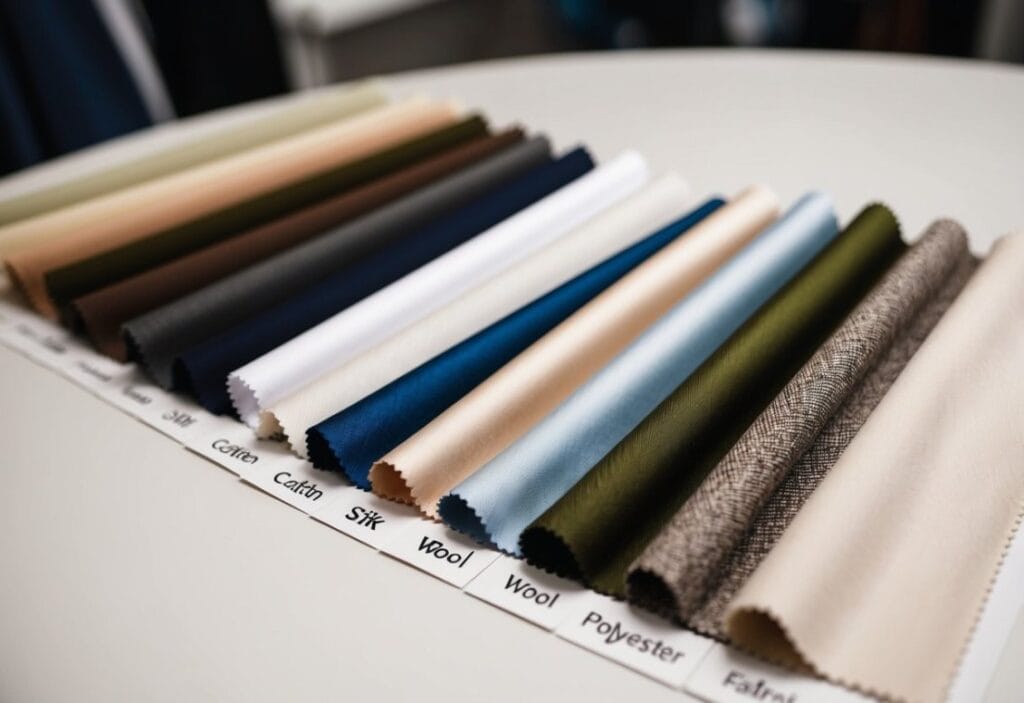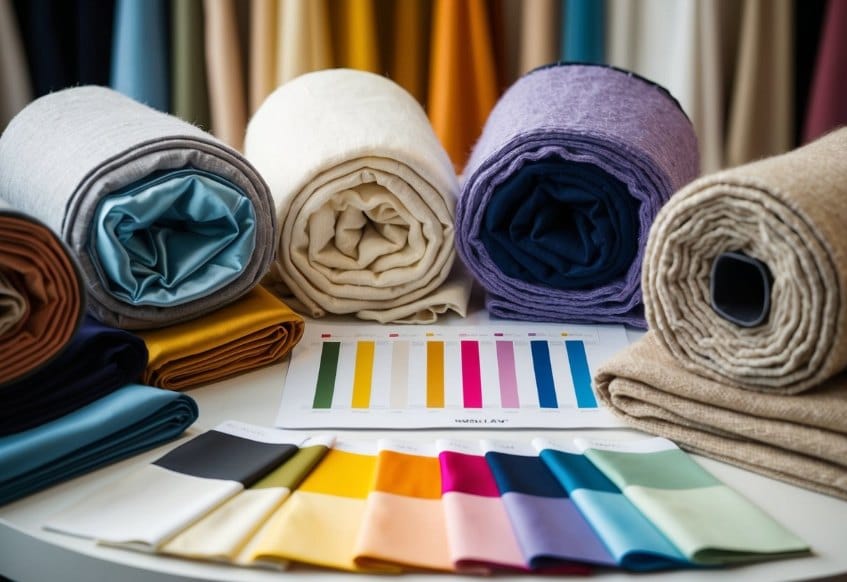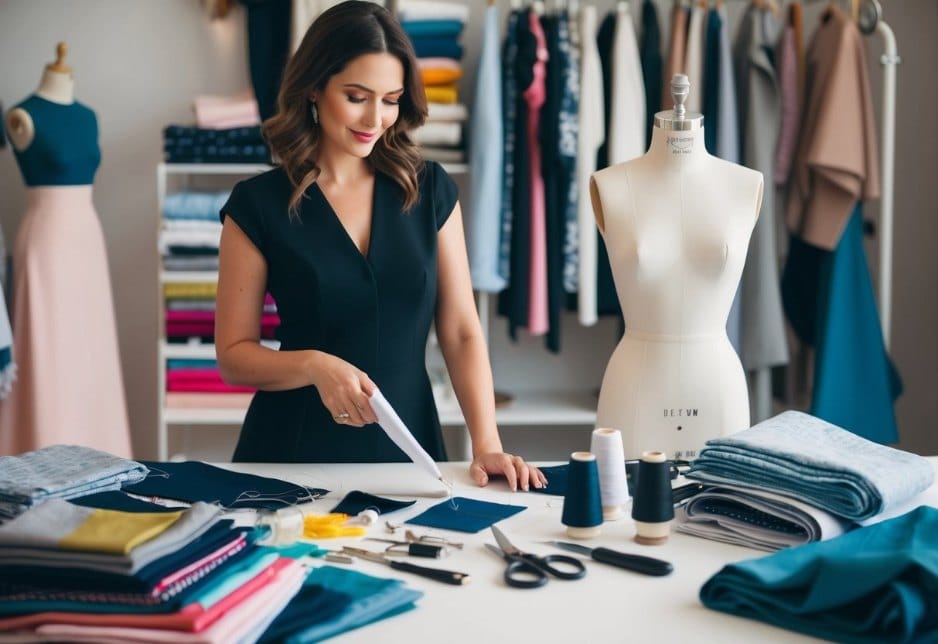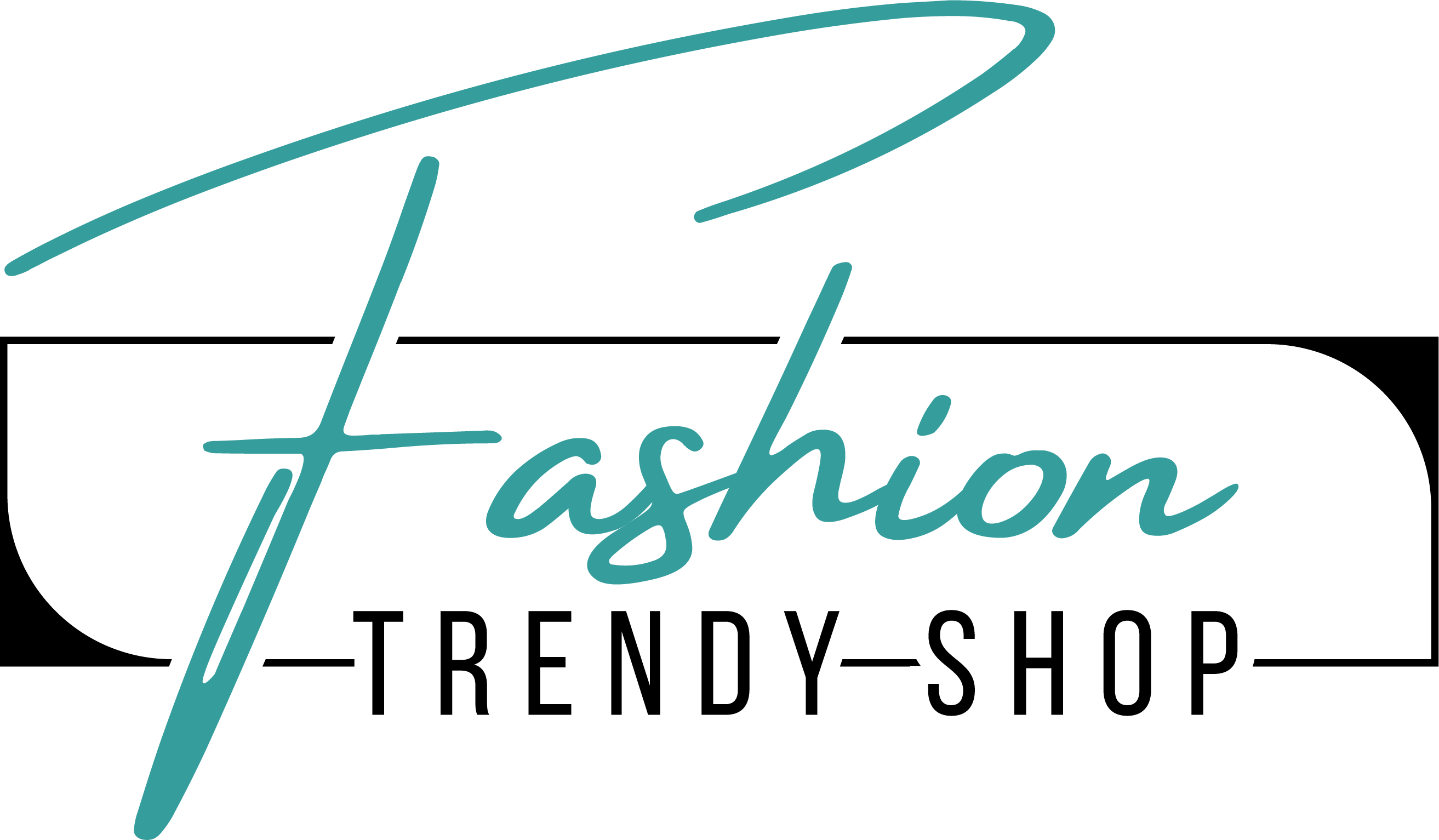Essential Guide for Fashion Enthusiasts
Choosing the right fabric is key to creating stunning womenswear. As a designer, I’ve learned that fabric can make or break a garment. It affects how a piece looks, feels, and wears over time. Understanding different fabric types and their properties is essential for making informed choices in fashion design and clothing selection.
Fabrics come in many forms, from soft silks to sturdy denims. Each type has unique traits that suit different styles and purposes. For example, chiffon creates flowing, romantic looks while wool offers warmth and structure. Knowing these differences helps match fabrics to specific designs and needs.
I find that exploring fabrics opens up exciting possibilities in fashion. It allows for creativity in texture, drape, and overall garment construction. Whether you’re a designer or simply love clothes, grasping fabric basics will enhance your style choices and appreciation for well-made clothing.
Table of Contents
Key Takeaways
- Fabric choice greatly impacts a garment’s look, feel, and durability
- Different fabrics have unique properties suited for various styles and uses
- Understanding fabrics enhances creativity in fashion design and personal style
The Basics of Fabric Types

Fabrics come in many varieties, each with unique properties. I’ll explore natural fibers from plants and animals, synthetic materials created in labs, and blends that combine different fiber types.
Natural Fibers
Natural fibers come from plants and animals. Cotton is soft, breathable, and easy to care for. I love how it feels cool against my skin on hot days. Linen, made from flax plants, is lightweight and durable. It wrinkles easily but that’s part of its charm.
Silk feels luxurious and smooth. It’s strong but delicate to clean. Wool keeps me warm and cozy. It resists wrinkles and dirt. Cashmere is a super soft type of wool. Alpaca wool is hypoallergenic and very warm.
Some less common natural fibers are hemp and bamboo. They’re eco-friendly options that feel nice to wear. I find natural fibers comfortable and versatile for many types of clothing.
Synthetic Fibers
Scientists created synthetic fibers in labs. Polyester is strong, wrinkle-resistant, and dries quickly. I like it for activewear. Nylon is also strong and stretchy. It works well for stockings and swimwear.
Spandex adds stretch to fabrics. It’s in my yoga pants and skinny jeans. Acrylic mimics wool but is lighter and easier to wash. I use it for warm sweaters.
Rayon is made from plant fibers but processed synthetically. It drapes nicely and feels silky. Synthetic fibers are often cheaper than natural ones. They can be very durable and easy to care for.
Blended Fabrics
Blended fabrics mix different fiber types. This combines the best qualities of each material. A cotton-polyester blend is comfy like cotton but wrinkles less. Wool-nylon socks are warm but stronger than pure wool.
Spandex is often blended with other fibers to add stretch. It makes jeans more comfortable. Cotton-linen blends are cooler than pure cotton but less wrinkly than linen alone.
I find blends practical for everyday wear. They often perform better than single-fiber fabrics. Blends can be more affordable too. The possibilities are endless with different fiber combinations.
Understanding Fabric Properties

Fabric properties play a crucial role in fashion design and garment construction. I’ll explore the key characteristics that impact how fabrics look, feel, and perform when used in womenswear.
Texture and Weight
Fabric texture refers to how a material feels to the touch. Some fabrics are smooth and silky, while others are rough or nubby. I find that texture greatly affects comfort and style.
Weight is another important factor. Light fabrics like chiffon flow and drape differently than heavy materials such as denim or wool coating. The weight impacts how a garment hangs on the body.
Fabric construction methods like weaving, knitting, or bonding affect texture and weight. A loose weave creates an airy texture, while a tight weave results in a smoother, denser fabric.
Comfort and Durability
Comfort is key for wearable garments. I look at factors like breathability, moisture-wicking, and stretch when assessing comfort. Natural fibers tend to be more breathable than synthetics.
Durability determines how well a fabric holds up to wear and washing. Tightly woven fabrics resist pilling and tearing better than loose weaves. Synthetic blends often boost durability.
Fabric finish treatments can enhance both comfort and durability. For example, water-resistant coatings improve weather protection, while softening treatments boost comfort.
Drape and Visual Appeal
Drape refers to how a fabric falls and moves. Flowing fabrics with good drape, like silk charmeuse, create elegant, body-skimming silhouettes. Stiffer fabrics hold their shape better.
Visual properties like sheen, texture, and print affect a fabric’s look. Shiny satins catch the light differently than matte cotton. Patterns and prints add visual interest and depth.
Color is another key visual element. Some fabrics take dye better than others, resulting in richer, more saturated hues. Fabric construction can also impact how colors appear.
Fashion and Function: Choosing the Right Fabric

Picking the perfect fabric is key for creating stylish and practical womenswear. I’ll explore how to match fabrics to different occasions and outfits, as well as sustainable options that look great and help the planet.
Occasions and Attire
For formal events, I recommend luxurious fabrics like silk, satin, or velvet. These add elegance and shine to evening gowns and cocktail dresses. Wool and cashmere work well for business attire, providing warmth and a polished look.
For casual wear, cotton is a top choice. It’s comfy, breathable, and easy to care for. Denim is great for jeans and jackets – it’s tough and long-lasting.
Workout clothes need stretchy, sweat-wicking fabrics. Nylon and spandex blends are ideal here.
Beach outfits call for light, airy materials. Linen and rayon keep you cool in the sun.
Sustainability and Eco-Friendly Options
Eco-friendly fabrics are becoming more popular in fashion. Organic cotton is grown without harsh chemicals, making it better for the earth and skin. It works well for t-shirts, dresses, and kids’ clothes.
Bamboo fabric is another green choice. It grows fast without pesticides and feels silky smooth.
Recycled polyester turns plastic bottles into clothes. It works great for activewear and outerwear.
Tencel is made from wood pulp in a closed-loop process. It’s soft, breathable, and biodegradable.
When shopping, I look for certifications like GOTS or Oeko-Tex to ensure fabrics meet eco standards.
Techniques for Working with Fabrics
I’ll cover key methods for handling different fabric types in womenswear. These techniques help create well-made garments with the right look and feel.
Sewing and Weaving
I start by choosing the right needle and thread for each fabric. For delicate silks, I use fine needles and silk thread. Heavier fabrics like denim need stronger needles and thicker thread.
When sewing stretchy knits, I use a zigzag stitch to allow movement. For wovens, a straight stitch works well. I always test stitches on scraps first.
Weaving creates many fabric types. Plain weave is simple and strong. Twill weave, used for denim, is more durable. Satin weave produces a shiny surface great for dressy items.
I match seam types to fabrics too. French seams work well on sheer fabrics. Flat-felled seams are sturdy for heavy materials.
Knitting and Textile Treatment
Knitting forms loops in yarn to make fabric. I use different needle sizes and yarn weights to change the knit’s thickness and drape.
Ribbing adds stretch. Cables create texture. Lace knitting makes airy, delicate fabrics perfect for summer tops.
I often treat fabrics to change their properties. Mercerizing cotton increases shine and strength. Sanding creates a soft nap on fabrics like flannel.
For synthetics, heat-setting helps hold pleats and shapes. I use fabric finishes to add water resistance or reduce wrinkling.
Blending fibers combines their best qualities. Cotton-polyester mixes are easy-care but more breathable than pure polyester.
Fabric Care and Maintenance
Taking care of your clothes is key to making them last. I’ll share some tips to keep your fabrics looking great.
First, always check the care label. It tells you how to wash and dry each item. Following these instructions helps avoid damage.
Sorting laundry is important. I separate lights, darks, and delicates. This stops colors from bleeding onto other clothes.
Here are some general washing tips:
- Use cold water for most loads
- Turn clothes inside out
- Zip zippers and fasten buttons
- Don’t overstuff the machine
Drying matters too. I hang delicate items to air dry. For machine drying, I use low heat and take clothes out promptly to reduce wrinkles.
Ironing can be tricky. I set the iron to match the fabric type. A spray bottle helps dampen stubborn wrinkles.
Storing clothes properly keeps them in good shape. I use padded hangers for knits and fold heavy sweaters to maintain their shape.
Spot cleaning can save time and money. I treat stains right away with the right cleaner for each fabric type.
With these simple steps, I keep my clothes looking fresh and extend their life. Good fabric care is an easy way to protect my wardrobe investment.
Frequently Asked Questions
What is fabric fundamentals?
Fabric fundamentals refers to the basic knowledge of textiles, including their composition, properties, and how they’re used in clothing and other products.
What are the basics of fabric?
The basics of fabric include fiber type (natural or synthetic), weave or knit structure, weight, drape, and care requirements.
What are the principles of design in fabric?
The main principles of fabric design are color, pattern, texture, balance, emphasis, and rhythm.
What are the 4 things to consider when choosing fabric?
The four main considerations are:
1. Purpose of the garment
2. Fabric care requirements
3. Season/climate
4. Personal comfort preferences.
How to start learning about fabrics?
Begin by familiarizing yourself with common fabric types, touching different materials, reading garment labels, and researching online resources or taking textile courses.
What are textile basics?
Textile basics include understanding fibers, yarns, fabric construction methods, finishes, and dyeing processes.
What are the 3 main types of fabric?
The three main types are:
1. Woven
2. Knitted
3. Non-woven fabrics.
What are the 3 main ways of fabric formation?
The three main ways are:
1. Weaving
2. Knitting
3. Felting/bonding (for non-wovens).
How do you categorize fabrics?
Fabrics can be categorized by fiber content (natural vs. synthetic), construction method (woven, knit, non-woven), weight, and end-use (apparel, home furnishings, industrial).
Which fabric is best for beginners?
Cotton is often recommended for beginners due to its ease of handling, versatility, and forgiving nature.
What is fabric with holes in it called?
Fabric with intentional holes is generally called “mesh” or “net” fabric. Specific types include lace, tulle, and fishnet.
What is that fuzzy fabric called?
Fuzzy fabrics are generally referred to as “pile” fabrics. Common types include velvet, fleece, and terry cloth.
What fabric holds its shape best?
Fabrics with good structure and shape retention include denim, twill, and certain synthetics like polyester.
What is a bumpy fabric called?
Bumpy fabrics are often referred to as “textured” fabrics. Specific types include boucle, seersucker, and pique.
What is wrinkled fabric called?
Intentionally wrinkled fabric is typically called “crinkle” fabric. Examples include crinkle cotton and crushed velvet.

